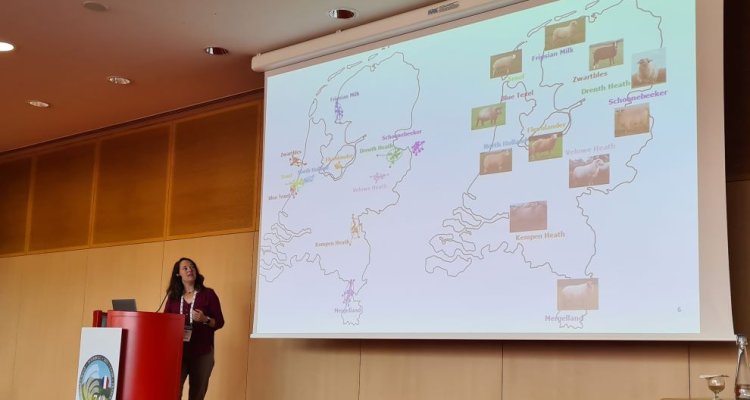
News
CGN presents new insights at the 74th EAAP annual meeting
The annual meeting of the European Federation of Animal Science (EAAP) in Lyon provided CGN researchers with an opportunity to share their latest insights, for example on native Dutch cattle breeds, sheep breeds and monitoring genetic variation within breeds. Read more about our presentations below.
Gerbrich Bonekamp presented a poster on the interaction between breeds and their environment, particularly the suitability of Dutch cattle breeds for low-input agricultural systems.
Intensification of Dutch agriculture led to a large replacement of native Dutch cattle breeds by Holstein-Friesians since 1970. However, with the transition towards more sustainable and less intensive agroecological farming systems, there is a renewed interest in native cattle breeds. Farmers especially mention their dual purpose and robust characteristics as reasons for choosing to work with these breeds. “A lot of people were interested in the topic, which was really nice.” says Gerbrich. “I think a poster is a really good way to present your research and it prompted people to share their views.”
Sheep diversity map causes buzz among audience
Expert Noelle Hoorneman gave a presentation on genetic diversity in Dutch sheep breeds. “The Netherlands has a rich variety of native sheep breeds from different geographic regions with different historic and present uses,” says Noelle. “Based on the number of breeding females, ten of these breeds are currently classified at risk with associated risks for high inbreeding levels. To gain more insight in the genetic structure of the Dutch sheep population, we studied the distinctiveness of the native breeds, their genetic diversity both within and between breeds, and how this diversity is shaped by geography, purpose, history and genetic management practices.”
Download the presentation 'Genetic variation in Dutch sheep breeds'
“Noelle’s presentation was well-received by the audience,” says researcher Jack Windig. “Particularly the conclusion that the graphical distribution of the principal components analysis showed a matching pattern to the geographical distribution of the origin of the different sheep breeds caused a buzz of voices from the people in the room.”
“The variation in the unique diversities of each breed showed that some breeds have a much larger contribution to the total genetic diversity than others,” says Noelle. “These differences can likely be explained by the population sizes, the use of foreign breeds in the past for the development of Dutch breeds and the use of genetic management such as rotational breeding schemes.” This information can be valuable in assessing the effects of genetic management measures, decisions for gene bank collections and in vivo breeding programmes, and it provides more insight in the structure of the Dutch native sheep population.
Monitoring within-breed genetic variation at a global level
Jack Windig also co-authored a presentation about monitoring within-breed genetic variation at a global level. Monitoring genetic variation is important, because it relates to a diversity of processes: for example mutation, genetic drift, selection and migration. The presentation focused on effective population size (Ne) as an indicator for genetic variation. Not only because it is a relevant and synthetic indicator of changes in genetic variation, but also because it is linked to drivers, mechanisms and consequences of changes in genetic variation, and because it is easy to understand and interpret. It can be estimated with diverse approaches and data sources.
Download the presentation 'Monitoring within-breed genetic variation at a global level'
Every year, the EAAP organizes an international meeting, which attracts between 900 and 2,000 people. This year, the meeting was held in Lyon, the capital of the Auvergne-Rhône-Alpes French region, from August 26th to September 1st, 2023.